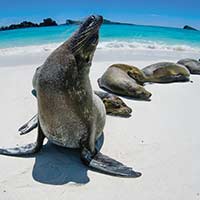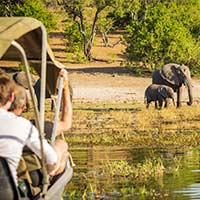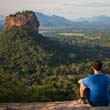Book NOW for $1 £1 €1 • Flexible Payments • No Change Fees • Private Departures Available
- Home >>
- Experiences >>
- Wildlife Spotting
- Wildlife Spotting Experiences
- Out of this World Wildlife Trips
- Fun Facts
- Experience Wildlife Spotting Holidays
- Responsible Travel Wildlife Tips
- Packing for Spotting Wildlife on Safari?
- Tip for Spotting Wildlife
- Packing Guide for Spotting Marine Wildlife
- Tucan Travel's responsible Wildlife Policy
- Tucan Travel's responsible Wildlife Policy
- Wildlife Blogs
Wildlife Spotting Experiences for Travellers
While David Attenborough has successfully brought the best cinematic wildlife experiences to our TV screens than ever seen before, nothing can quite compare to witnessing animals in the wild with your own eyes. From tracking down the Big Five in Africa, walking with giant tortoises in the Galapagos Islands or spotting caiman on an Amazon Cruise, nature loving travellers will be in their element viewing wildlife on tour. Experiencing the world’s wildlife in their natural habitat is expecting the unexpected - and always having the camera ready! Embark on a wildlife tour with Tucan Travel to soak up nature and escape everyday life, whether it’s on a safari, marine trip or jungle cruise.
Out of this World Wildlife Experiences
Facts you never knew about Wildlife
Things you never knew about wildlife
Which national park in Botswana is known for its elephant population?
hover to find out
Chobe
…...is known for its large herds of elephants, it’s estimated the park has over 100,000!
Things you never knew about wildlife
How many national parks and reserves are in Africa?
hover to find out
268!
There are an incredible...national parks in Africa.The countries with the most are Kenya (23), Zambia (20) and South Africa (19)
Things you never knew about wildlife
Which collection of islands were named after tortoises?
hover to find out
The Galapagos
……were named by the Spanish when they first discovered them in 1570.
Out of this World Wildlife Experiences
Spot Wildlife on Safari
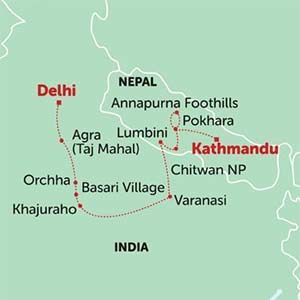
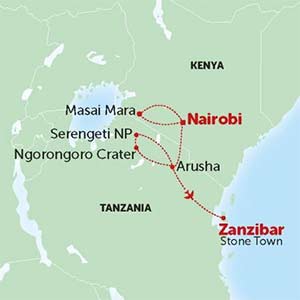
Southern Africa Adventure
Duration: 31 Days
Route:Pretoria to Cape Town
Tour Code:AFSL
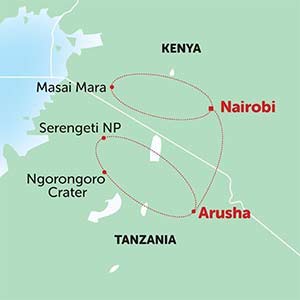
Bird-spotting Trips
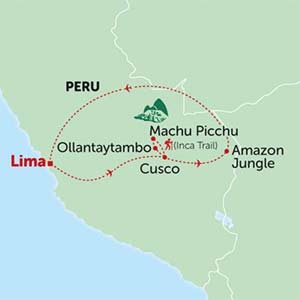
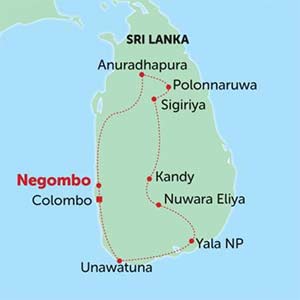
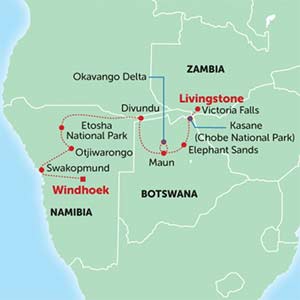
Botswana & Namibia
Duration: 13 Days
Route:Livingstone to Windhoek
Tour Code:AFBN
Marine Wildlife Tours
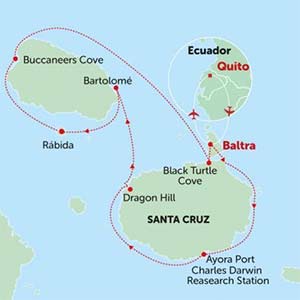
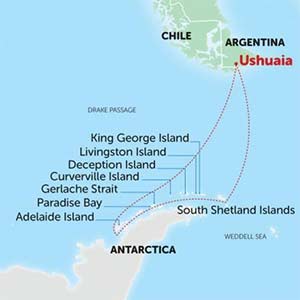
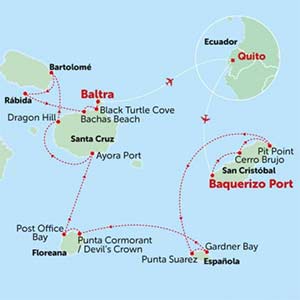
Top three Responsible Travel tips for your wildlife holiday
1
Be aware of your waste and ensure you never accidentally leave litter behind. This can easily be eaten by wildlife and cause harm and illness. Be vigilant about what you bring, try to avoid single use plastic and always bring waste back to your accommodation to dispose of properly. If you do spot litter in an area of wildlife, bring it back with you to dispose of, so long as it is safe to do so.
2
Do not geotag your location on social media when you are on a safari. It is known that poachers use this method to track down where some endangered species are spotted. Either give a generic tag, such as “Serengeti National Park” or do not tag at all. Your local guide will be able to give you advice on this so always listen carefully.
3
Keep an eye out for unethical animal practises in your destination. This could be anything from captive wild animals being used for selfies, animals that generally look malnourished and unwell in conservation parks or riding wild animals. If you are unsure where to report this, the first step is to contact our purpose officer at This email address is being protected from spambots. You need JavaScript enabled to view it..
Staff Top Tip

Anneka
Job Title: Tailor-made Specialist
Favourite Destination: Botswana
I highly recommend visiting Botswana during the “green season” which is normally from December through to March. While there are showers, they are very sporadic. The highlight of visiting at this time is the birth of many baby animals. I saw young impala, zebra hiding by their mothers and baby lion cubs playing. You could sit and watch them all day but you also realise how vulnerable they are with predators at large on the hunt. You never know what might happen! Of course, Botswana’s high season runs from June to October, which is an excellent time for general wildlife spotting because the grassland is more sparse.
If you want to enjoy an exhilarating walking safari experience, the dry season is the best time to visit since the shorter grass will give you the best chance at seeing predator sightings. A professional guide will show you how to identify the tracks, learn all about different animal smells and ultimately make you feel like you are part of the experience, not just observing from a distance. Everyday is different and you never know what you might come across! Finally, you can’t leave Botswana without cruising down the delta on a mokoro - keep your eyes peeled for hippos, crocodiles and lots of birds.
What to Pack for Spotting Wildlife on Safari?
Safaris are a casual affair, and you should leave any designer or expensive gear at home. The roads are dusty and your clothing will get a little dirty, so bear this in mind. You should consider the country you are visiting and the time of year when packing for your safari. If you are embarking on the gorilla trek we have a page on that specific packing guide.
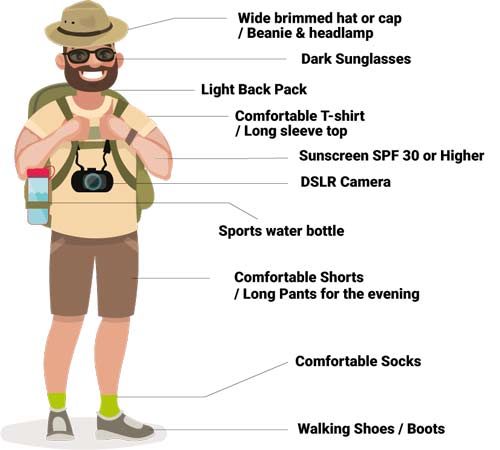
Packing list - Clothing
- Comfortable shoes/boots built for hard or rough terrain
- Lighter footwear for wearing on the boat
- Swimwear
- Rain Jacket
- Sweater or fleece
- Loose shorts and trousers (and at least one waterproof pair)
- Jeans or other trousers for evenings on the ship
- Normal and walking socks
- Quick drying t-shirts/tops
- Swimwear cover-up or sarong/
- Underwear & Pyjamas
- One long sleeved top for cooler nights
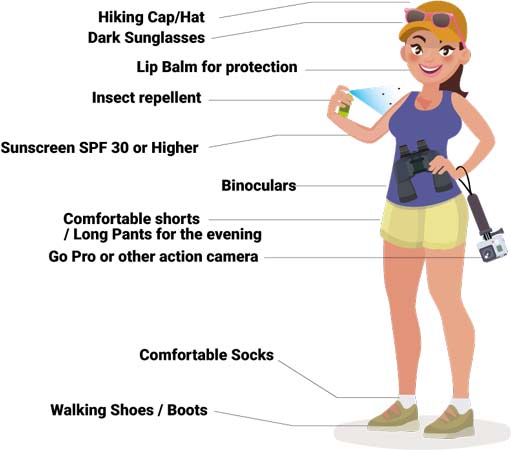
Packing List - other essential items
- Binoculars
- Worldwide Adaptor
- Motion Sickness Tablets if applicable
- Toiletries and personal medication
- Electronic and chargers
- Sun Cap/Hat
- Sun Screen (at least SPF30) and Lip Balm
- Sunglasses
- Anti-Fog Spray for snorkel gear
- Dry bag for on shore excursions
- Laundry Bag
- Insect Repellent
Top tips for Spotting Wildlife

Take a Camera
Bring a camera with a long-range lens for the best shots of animals in the distance.

Plan for Active Times
Book onto tours that run at dawn and dusk, when the animals are most active.

Take Binoculars
Bring a pair of binoculars. Most animals blend into their surroundings and are hard to spot with the naked eye.

Follow the Guides
Follow the guidelines set out by your local guide - they are there to help you!
Packing Guides for Spotting Marine Wildlife
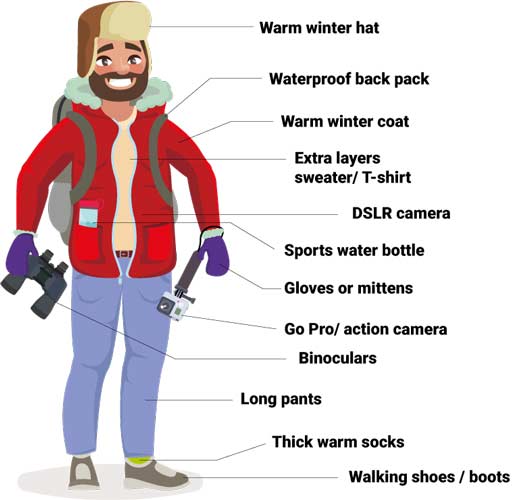
Packing list - Clothing for Cold Climates
- Comfortable shoes/boots built for hard or rough terrain
- Lighter footwear for wearing on the boat
- Swimwear
- Rain Jacket
- Sweater or fleece
- Loose shorts and trousers (and at least one waterproof pair)
- Jeans or other trousers for evenings on the ship
- Normal and walking socks
- Quick drying t-shirts/tops
- Swimwear cover-up or sarong/
- Underwear & Pyjamas
- One long sleeved top for cooler nights
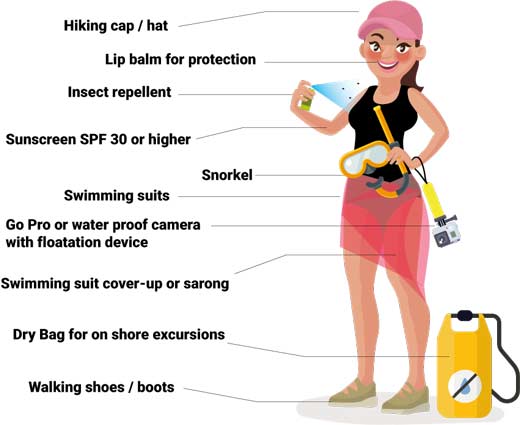
Packing List - Clothing for Warm Climates
- Binoculars
- Worldwide Adaptor
- Motion Sickness Tablets if applicable
- Toiletries and personal medication
- Electronic and chargers
- Sun Cap/Hat
- Sun Screen (at least SPF30) and Lip Balm
- Sunglasses
- Anti-Fog Spray for snorkel gear
- Dry bag for on shore excursions
- Laundry Bag
- Insect Repellent
Tucan Travel’s Responsible Wildlife Policies

Local Accommodation
We work with local accommodation suppliers who share the same conservation and responsible travel procedures as ourselves.

Trained guides and tour leaders
Our tour leaders and local guides are passionate about wildlife and are trained in how to travel through parks and reserves responsibly.

Strict commitment to animal protection
Tucan Travel follow ABTA’s Five Freedom Policy for animals.
Best Time to do a Wildlife Holiday
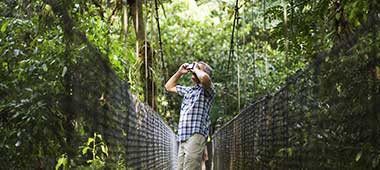
Best time to do Costa Rica
Costa Rica has an abundance of wildlife which can be seen at any time of year. However the dry season in Costa Rica runs from December to April and is the best time to visit to avoid heavy rainfall.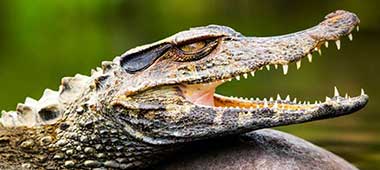
Best time for the Amazon
There is really no “best” time as animals are in abundance year round. During low water (May/June to October/November) it's easier to spot aquatic wildlife such as caiman and anaconda. The high water season (November to May/June) is when many of the trees drop fruit which in turn attracts monkeys and other foraging animals.
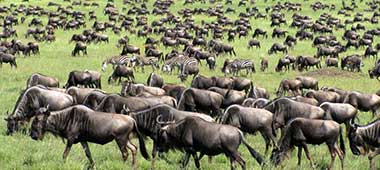
Best time for the Wildebeest migration
The Wildebeest Migration is the movement of around two million wildebeest, as well as zebras, gazelles and antelope, across the plains of the Serengeti and Masai Mara in search of fresh water and grass. This spectacular sight can be seen anytime between November to July, depending on where you are.
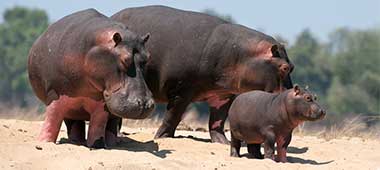
Best time for seeing baby animals in Africa
The good news is that furry little lion cubs and floppy eared newborn elephants can be spotted at any time of year - just keep your eyes peeled and fingers crossed! Other animals such as wildebeest tend to bear their young between the two wet seasons.
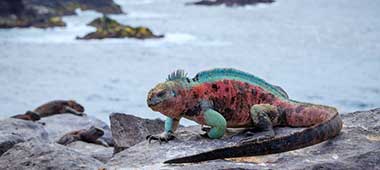
Best time for visiting the Galapagos Islands
The best time to visit the Galapagos is the warmer, wet season from December to June. Showers tend to be short and underwater visibility is at its best. However, with such a huge variety of animals on the islands it's possible to see them anytime.
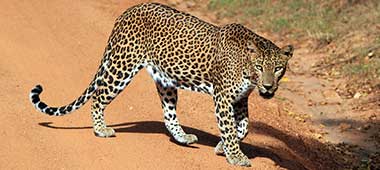
Best time for seeing wildlife in Sri Lanka
If you are visiting Udawalawe National Park to spot elephants, the best time to visit is in the main dry season of June to October. As many watering holes dry up at this time, animals go to specific ones for a drink making them easier to spot. Yala National Park follows a similar climate and is also best visited from May/June through to October.
Wildlife Travel Blogs
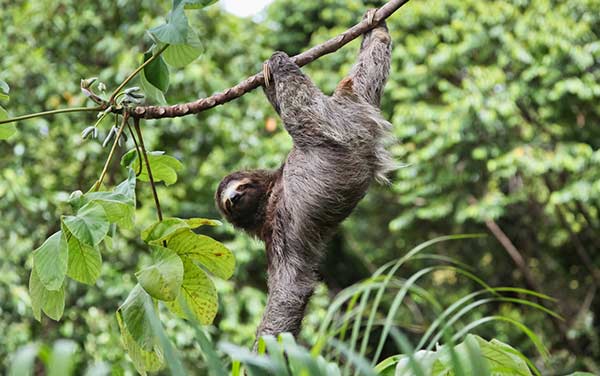
Slothing around Costa Rica
My mind was made up, it was time…. time to meet a sloth. I’d been to Central America before, and been to South America, but I’d never experienced a sloth sighting. Desperate times call for desperate decisions and so I decided to make my way to Costa Rica with the express intent on seeing at least one sloth. Of course to go all that way and not see some other wildlife seemed a little too rash, so onto the Tucan Travel San Jose to Panama City tour I booked.
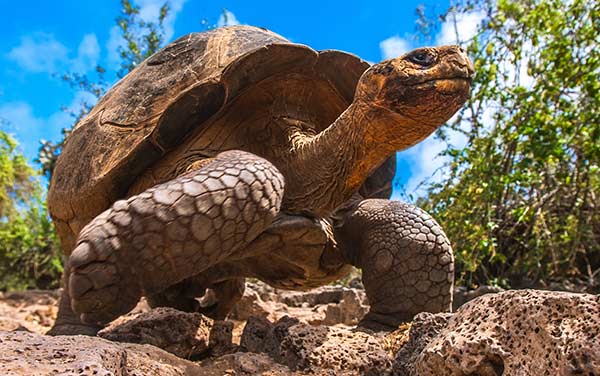
10 unique animals of the Galapagos Islands
A cruise to the famed Galapagos Islands is a once in a lifetime opportunity and a mecca for wildlife buffs. The archipelagos consists of 20 islands with only 4 being inhabited. Going on a Galapagos tour is like walking into a David Attenborough documentary! And the animals here are not your ordinary type – they are very unique, many you can only find in this part of the world. A Galapagos tour is a great chance to get up close and personal with rare animals – they are completely fearless and won’t even look twice when you approach to grab that money shot!





